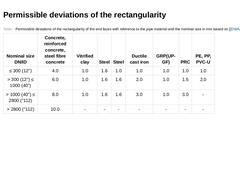
|
(Table: Permissible deviations of the rectangularity of the end faces with reference to the pipe material and the nominal size in mm) |

|
|
(Image: Attention!)
In determining the pipe length of the jacking pipe to be inserted (pipe length plus when available, the thickness of the pressure transfer ring in the uncompressed condition), the installation method must be taken into account. |
|
(Table: Permissible pipe length tolerances with reference to the nominal size of the jacking pipes) |
Preferred lengths of jacking pipes for pressing- in, pushing-in or ramming-in are 1000 mm, 2000 mm, … |
|
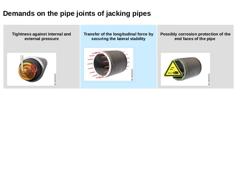
|

| Tightness against internal and external pressure
(Image: Leaktightness)
| Transfer of the longitudinal force by securing the lateral stability (Image: Transfer of the longitudinal force)
| Possibly corrosion protection of the end faces of the pipe
(Image: Corrosion protection end faces of the pipe)
|
|
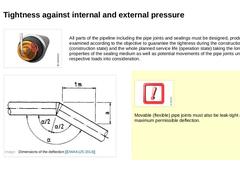
|
|
(Image: Leaktightness) |
All parts of the pipeline including the pipe joints and sealings must be designed, produced and examined according to the objective to guarantee the tightness during the construction works (construction state) and the whole planned service life (operation state) taking the long-term properties of the sealing medium as well as potential movements of the pipe joints under the respective loads into consideration. |
|
|
(Image: … |
|
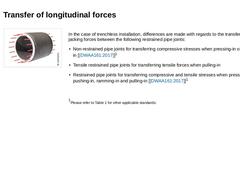
|
|
(Image: Transfer of the longitudinal force) |
In the case of trenchless installation, differences are made with regards to the transfer of the jacking forces between the following restrained pipe joints: -
Non-restrained pipe joints for transferring compressive stresses when pressing-in or pushing-in [ [DWAA161:2017]]1
-
Tensile restrained pipe joints for transferring tensile forces when pulling-in
-
Restrained pipe joints for transferring compressive …
|
|
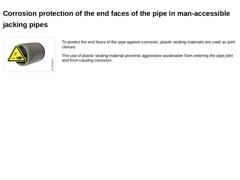
|

|
(Image: Corrosion protection end faces of the pipe) |
To protect the end faces of the pipe against corrosion, plastic sealing materials are used as joint closure.
The use of plastic sealing material prevents aggressive wastewater from entering the pipe joint and from causing corrosion. |
|
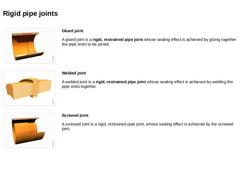
|

| (Image: Adhesive joint)
|
Glued joint A glued joint is a rigid, restrained pipe joint whose sealing effect is achieved by gluing together the pipe ends to be joined. | | (Image: Welding bead)
|
Welded joint A welded joint is a rigid, restrained pipe joint whose sealing effect is achieved by welding the pipe ends together. | | (Image: Screwed joint)
|
Screwed joint A screwed joint is a rigid, restrained pipe joint, whose sealing effect is achieved by the screwed … |
|
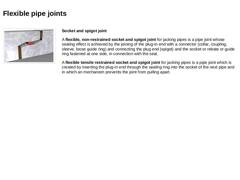
|

|
(Image: Pressure transfer over the inner or outer front face of a lip joint with reference to [BS5911] - with rolling ring [Image: S&P GmbH]) |
Socket and spigot joint A flexible, non-restrained socket and spigot joint for jacking pipes is a pipe joint whose sealing effect is achieved by the joining of the plug-in end with a connector (collar, coupling, sleeve, loose guide ring) and connecting the plug end (spigot) and the socket or rebate or guide … |
|
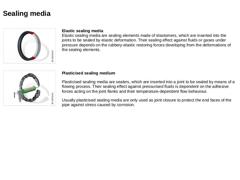
|

|
(Image: Elastic sealing media) |
Elastic sealing media
Elastic sealing media are sealing elements made of elastomers, which are inserted into the joints to be sealed by elastic deformation. Their sealing effect against fluids or gases under pressure depends on the rubbery-elastic restoring forces developing from the deformations of the sealing elements. |
|
(Image: Plasticised sealing medium) |
Plasticised sealing medium Plasticised sealing media are … |
|
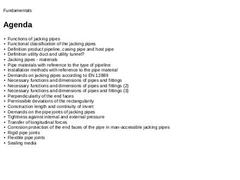
|

|
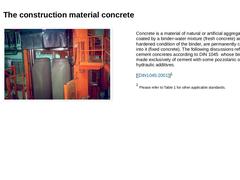
|
(Image: Production of concrete pipes) Concrete is a material of natural or artificial aggregates that are coated by a binder-water mixture (fresh concrete) and, in the hardened condition of the binder, are permanently cemented into it (fixed concrete). The following discussions refer to cement concretes according to DIN 1045 whose binder is made exclusively of cement with some pozzolanic or latently hydraulic additives. [ [DIN1045:2001]]1 1Please refer … |
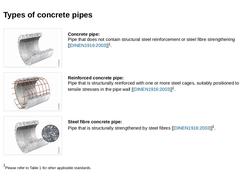
|
|
(Image: Concrete pipe)
Concrete pipe:
Pipe that does not contain structural steel reinforcement or steel fibre strengthening [ [DINEN1916:2003]]1. |
|
(Image: Reinforced concrete pipe)
Reinforced concrete pipe:
Pipe that is structurally reinforced with one or more steel cages, suitably positioned to resist tensile stresses in the pipe wall [ [DINEN1916:2003]]1. |
|
(Image: Steel fibre concrete pipe)
Steel fibre concrete pipe:
Pipe that is structurally … |
|
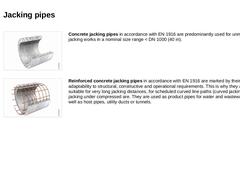
|
|
(Image: Concrete pipe) |
Concrete jacking pipes in accordance with EN 1916 are predominantly used for unmanned jacking works in a nominal size range < DN 1000 (40 in). |
|
(Image: Reinforced concrete pipe) |
Reinforced concrete jacking pipes in accordance with EN 1916 are marked by their wide adaptability to structural, constructive and operational requirements. This is why they are suitable for very long jacking distances, for scheduled curved line … |
|
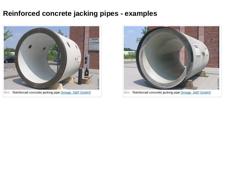
|
(Image: Reinforced concrete jacking pipe) (Image: Reinforced concrete jacking pipe - Double seal in spigot end) (Image: Reinforced concrete jacking pipe - Safety bolt against rolling of the pipe string) (Image: Reinforced concrete jacking pipe - Steel guide ring, pressure transmission ring made of wood and opening for securing bolts against rolling of the pipe string) (Image: Reinforced concrete jacking pipe - Equipped with lubrication station) |
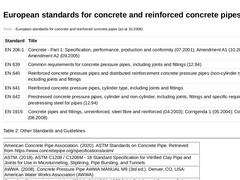
|
(Table: European standards for concrete and reinforced concrete pipes (as at 10.2008)) Table 2: Other Standards and Guidelines
|
American Concrete Pipe Association. (2020). ASTM Standards on Concrete Pipe. Retrieved from https://www.concretepipe.org/specifications/astm/ |
|
ASTM. (2018). ASTM C1208 / C1208M - 18 Standard Specification for Vitrified Clay Pipe and Joints for Use in Microtunneling, Sliplining, Pipe Bursting, and Tunnels |
|
AWWA. (2008). Concrete … |
|
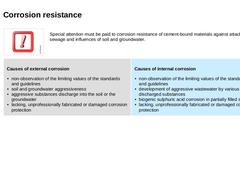
|
|
(Image: Attention!)
Special attention must be paid to corrosion resistance of cement-bound materials against attacks by sewage and influences of soil and groundwater. |
|
Causes of external corrosion -
non-observation of the limiting values of the standards and guidelines
-
soil and groundwater aggressiveness
-
aggressive substances discharge into the soil or the groundwater
-
lacking, unprofessionally fabricated or damaged corrosion protection
|
Causes … |
|
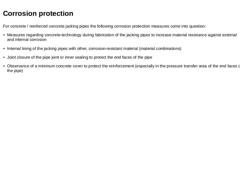
|

For concrete / reinforced concrete jacking pipes the following corrosion protection measures come into question: -
Measures regarding concrete-technology during fabrication of the jacking pipes to increase material resistance against external and internal corrosion
-
Internal lining of the jacking pipes with other, corrosion-resistant material (material combinations)
-
Joint closure of the pipe joint or inner sealing to protect the end faces of the pipe
|
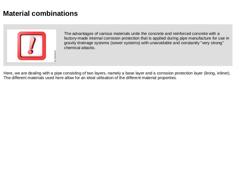
|

| (Image: Attention!)
The advantages of various materials unite the concrete and reinforced concrete with a factory-made internal corrosion protection that is applied during pipe manufacture for use in gravity drainage systems (sewer systems) with unavoidable and constantly "very strong" chemical attacks. | |
Here, we are dealing with a pipe consisting of two layers, namely a base layer and a corrosion protection layer (lining, inliner). The different … |
|
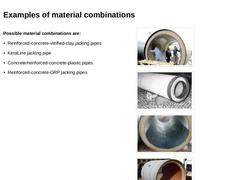
|
Possible material combinations are: -
Reinforced-concrete-vitrified-clay jacking pipes
-
KeraLine jacking pipe
-
Concrete/reinforced-concrete-plastic pipes
-
Reinforced-concrete-GRP jacking pipes
(Image: Reinforced concrete jacking pipe with inner lining of plastics) (Image: BKU reinforced concrete jacking pipes - View) (Image: Concrete pipe with invert lining of cast-basalt elements) (Image: Concrete pipe with vitrified clay plates) |
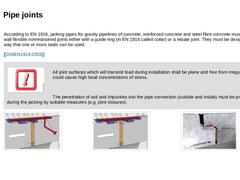
|
|
According to EN 1916, jacking pipes for gravity pipelines of concrete, reinforced concrete and steel fibre concrete must possess in-wall flexible nonrestrained joints either with a guide ring (in EN 1916 called collar) or a rebate joint. They must be designed in such a way that one or more seals can be used. [ [DINEN1916:2003]] |
|
(Image: Attention!)
All joint surfaces which will transmit load during installation shall be plane and free from irregularities … |
|
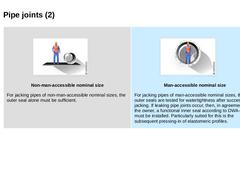
|
|
(Image: Non man-accessible)
Non-man-accessible nominal size For jacking pipes of non-man-accessible nominal sizes, the outer seal alone must be sufficient. |
(Image: Man-accessible)
Man-accessible nominal size For jacking pipes of man-accessible nominal sizes, the outer seals are tested for watertightness after successful jacking. If leaking pipe joints occur, then, in agreement with the owner, a functional inner seal according to DWA-A 125 must be … |
|
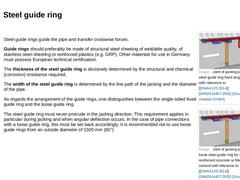
|
Steel guide rings guide the pipe and transfer crosswise forces. Guide rings should preferably be made of structural steel sheeting of weldable quality, of stainless steel sheeting or reinforced plastics (e.g. GRP). Other materials for use in Germany must possess European technical certification. The thickness of the steel guide ring is decisively determined by the structural and chemical (corrosion) resistance required. The width of the steel guide … |
|
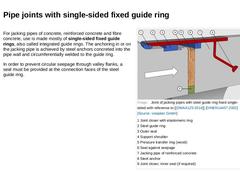
|
For jacking pipes of concrete, reinforced concrete and fibre concrete, use is made mostly of single-sided fixed guide rings, also called integrated guide rings. The anchoring in or on the jacking pipe is achieved by steel anchors concreted into the pipe wall and circumferentially welded to the guide ring. In order to prevent circular seepage through valley flanks, a seal must be provided at the connection faces of the steel guide ring. |

|

When arranging a loose guide ring, all pipe ends are identical. In order to avoid the entrance of soil particles into the gap between the guide ring and the jacking pipe, use is made of so-called joint closure based on subsequently installed elastomeric rings or swelling rubber seals. (Image: Joint of jacking pipes with loose steel guide ring for concrete, reinforced concrete or fibre cement) |
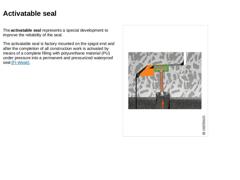
|

The activatable seal represents a special development to improve the reliability of the seal. The activatable seal is factory mounted on the spigot end and after the completion of all construction work is activated by means of a complete filling with polyurethane material (PU) under pressure into a permanent and pressurized waterproof seal [FI-Westr]. (Image: New development for the sealing of pipe joints - Gasket can be activated with reference to [… |